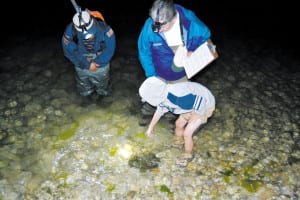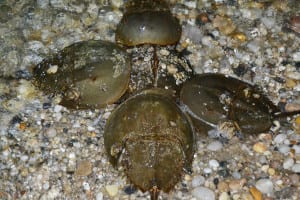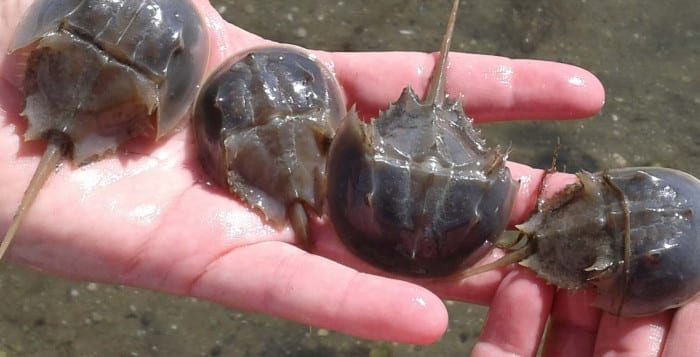Horseshoe crabs have been on Earth for almost 500 million years, but their future is uncertain. Researchers like Matt Sclafani, a marine educator from the Cornell Cooperative Extension in Riverhead, said he believes that the species is in an alarming decline.
“It’s a very important issue for a lot of reasons,” Sclafani said during a horseshoe crab monitoring session at West Meadow beach in Stony Brook on Monday night.
Horseshoe crabs are a valuable species to human life, Sclafani said. Their blue blood is used for pharmaceutical purposes. Fishermen use them as one of the most effective sources of bait that exists.
Sclafani called Delaware Bay the epicenter for horseshoe crab spawning activity, with Long Island coming in as a close second as one of the most important areas to the species on the East Coast, he said.
Sclafani and his team of volunteers take to the local shores when the tides are low, usually in the middle of the night, to count and tag horseshoe crabs that come up to the shore to spawn. On Monday, Sclafani was joined by Frank Chin, the regular site coordinator for West Meadow beach, along with Grace Scalzo, a volunteer, and Karen Papa and her sons — 12-year-old Zachary and 8-year-old Jonah.

“We get a lot of volunteers for this program,” Sclafani said. “That’s the part I think is really great, too. We get people involved in their backyards. There’s not a lot of marine life that you can get involved with and handle this directly — that comes right out onto the beach for you without a net or fishing pole.”
In all, the team tagged 55 horseshoe crabs over the course of the night, though that is nothing compared to the night on the South Shore when Sclafani said he and a team of about 35 volunteers tagged about 800 crabs. The process requires measurement, drilling a small hole into the shell, and then applying a round tag that has tracking information on it which is recorded.
“I think the entire population up and down the East Coast is in trouble,” Larry Swanson, associate dean of the Stony Brook University School of Marine and Atmospheric Sciences, said of the horseshoe crab population in an interview last week. “It’s in trouble for a variety of reasons including people overfishing the population, but also certain birds, including the red knot, are particularly prone to using them as a food source.”
Sclafani said the consequences could be dire, if the crabs are not saved.
“Their eggs are really important to the ecosystem,” Sclafani said. “A lot of animals feed on them, including migratory shore birds.”
Town of Brookhaven Supervisor Ed Romaine (R) divulged plans to urge the Department of Environmental Conservation to expand restrictions on harvesting horseshoe crabs in May, to the chagrin of fishermen. Those plans have since been tabled.
“I’m just a man, but I’m a vital part of the food chain and I think I’m at the top,” Ron Bellucci Jr. of Sound Beach said in an interview last month.
Horseshoe crab harvesting is a vital part of his income, he said. Local fishermen have also questioned the validity of claims about the declining population.

The idea that the species may not be declining is not an encouraging sign to Malcolm Bowman, professor of physical oceanography and distinguished service professor at SoMAS, Stony Brook. He is also the president of Stony Brook Environmental Conservancy and the Friends of Flax Pond, two environmental advocacy groups.
“We know in nature that things go up and down, and up and down, but you have to look at long-term trends; 10 years, 20 years,” Bowman said in an interview last week. “I’ve worked with fishermen a lot. They have to make a living, I understand that, but it’s important to keep communications between the scientists and say the fishermen with mutual respect, and that way we can learn a lot from them. We scientists are trained to have a long-term view. It’s not just this season, this summer, this breeding season. It’s a long-term view. I think that’s so important.”
More restricted areas, which Romaine is pushing for, could simply result in overharvesting in areas without restrictions, both Bowman and Sclafani said.
There has also been some experimentation with extracting the blue blood while the animal is still alive, then rereleasing them into the water. This process is called biomedical harvesting.
“That’s becoming a more and more controversial topic,” Sclafani said. “The biomedical companies have maintained that it’s a low mortality rate — about 10 percent … they might even be as high as 40 or 50 percent.”
He also mentioned that there are concerns about the horseshoe crabs’ spawning activity after this process is completed.
Bowman stopped short of saying that the extinction of the horseshoe crab would have a drastic impact on human life, but it’s not a good sign.
“I was reading some very important news that’s coming out about the extinction of species on the planet,” Bowman said. “Species are going extinct at a huge rate. The cumulative effect is going to have a very bad effect on human civilization, far greater than we can imagine. We only see a little piece of it.”





